Did you know I’m also a Ham radio operator? I guess guys who like Vintage Computers also like Ham Radios. In this post I’m going to talk about a new Magnetic Loop antenna made by Ciro Mazzoni, purchased from DX Engineering.
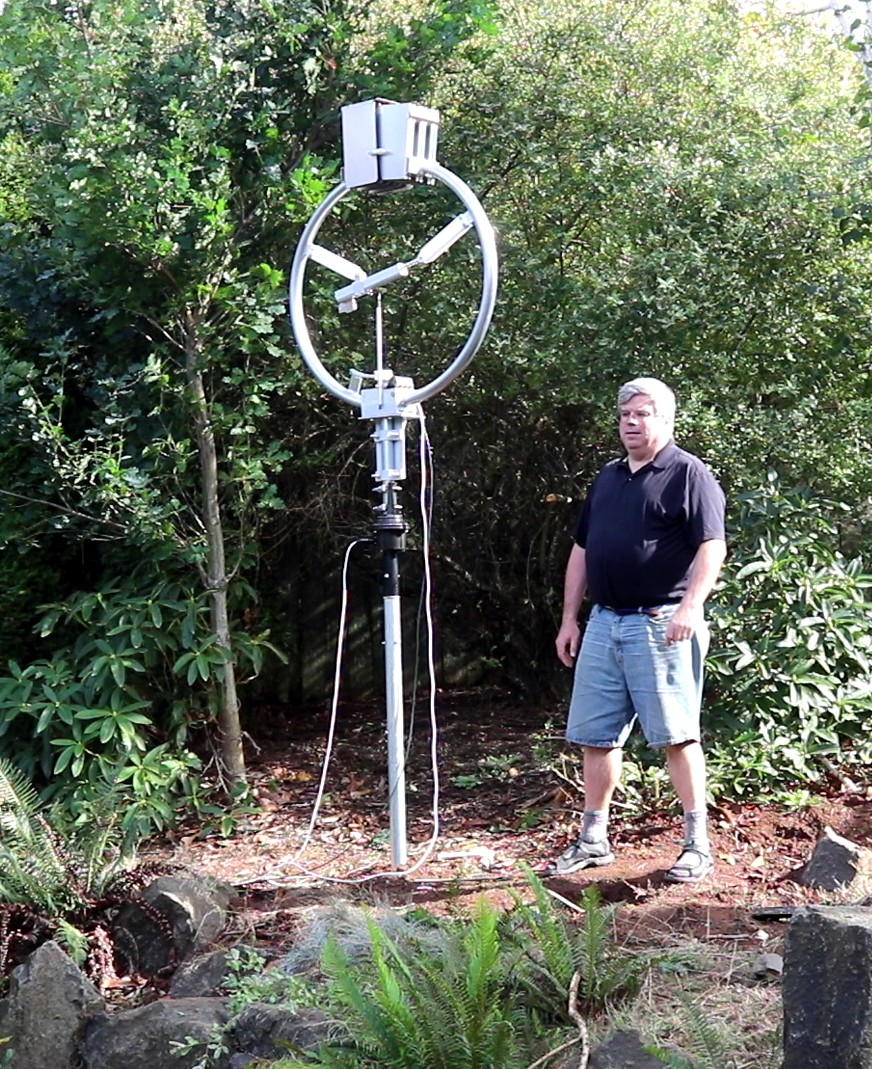
Why?
The antenna that I usually use is an End Fed Half Wave (EFHW) made by myantennas.com. It works on a variety of bands, including 40M, 20M, 15M, and 10M. However, it is hard to get good SWR at all of those bands, and especially across the whole of any band. I live in one of those parts of the city where you cannot put up a large visible antenna, so my EFHW is a wire in the backyard at the second story height of my home.
I’ve repeatedly read that a Magnetic Loop antenna installed close to the ground (5ft or so) can in some circumstances equal the performance of, or even outperform a dipole at a height of many meters. So I decided to spend some money and put this to the test.
What is a Magnetic Loop Antenna?
The Magnetic Loop Antenna, in particular what is known as the “Small Magnetic Loop”, is a large loop with a capacitor that resonates at the appropriate frequency we need to transmit and/or receive at. We all know (or should know) that to operate properly an antenna such as a dipole, needs to resonate at the correct frequency. If it doesn’t then we end up with our power reflected back to us rather than being transmitted to our destination. The tune a dipole to the appropriate frequency, we often trim or extend the length of the dipole as necessary. If we built a large enough loop, then we could do the same thing. This would be known as a “large loop”.
What we’re going to talk about here are “small loops”, that is loop antennas that are smaller than a quarter wavelength of the band they’re going to operate on. They won’t resonate on their own — you need to add a capacitor to achieve that. Typical construction uses either an air-variable capacitor (typically a series of plates with gaps between them) or a vacuum capacitor (a much smaller glass tube, with a vacuum). The capacitor needs to be sized appropriately so it does not arc at the high voltages involved, and you either do that by making a big air variable capacitor, or you buy a vacuum cap which has the air removed.
Magnetic loops are usually coupled to the transmitter using either a smaller loop, or something called a gamma match. I’m not going to dive into all the theory that makes this possible, I’m going to jump into selecting, installing, and using my new magnetic loop antenna.
The advantages of a magnetic loop antenna include:
- Small size compared to a resonant dipole.
- Ability to be mounted much lower to the ground than a dipole, while still achieving reasonable performance.
- Can be tuned to a variety of frequencies. It’s not uncommon for a loop to be tunable from 10M to 40M, or on some larger loops, 80M.
- Directional nature allows you to null out unwanted signals.
- Narrow bandwidth allows you to often tune out adjacent noise. This advantage is also a considerable disadvantage in that you have to retune your magnetic loop every time you change frequency.
- The small size and low-to-the-ground properties make them convenient for portable operations.
Choosing a Magnetic Loop Antenna
My choice came down to two options. The first was the PreciseRF HG3 QRO. I’ve met with the PreciseRF team at their booth twice at Seapac, and have attended their lectures. They’re great, helpful people who have a wealth of information. The HG3 QRO is a nice antenna using a vacuum capacitor and a stepper drive. There’s some circuitry inside the control box. It uses heavy coax to form the loop itself. There’s an internal control box that looks well designed and has plenty of features.
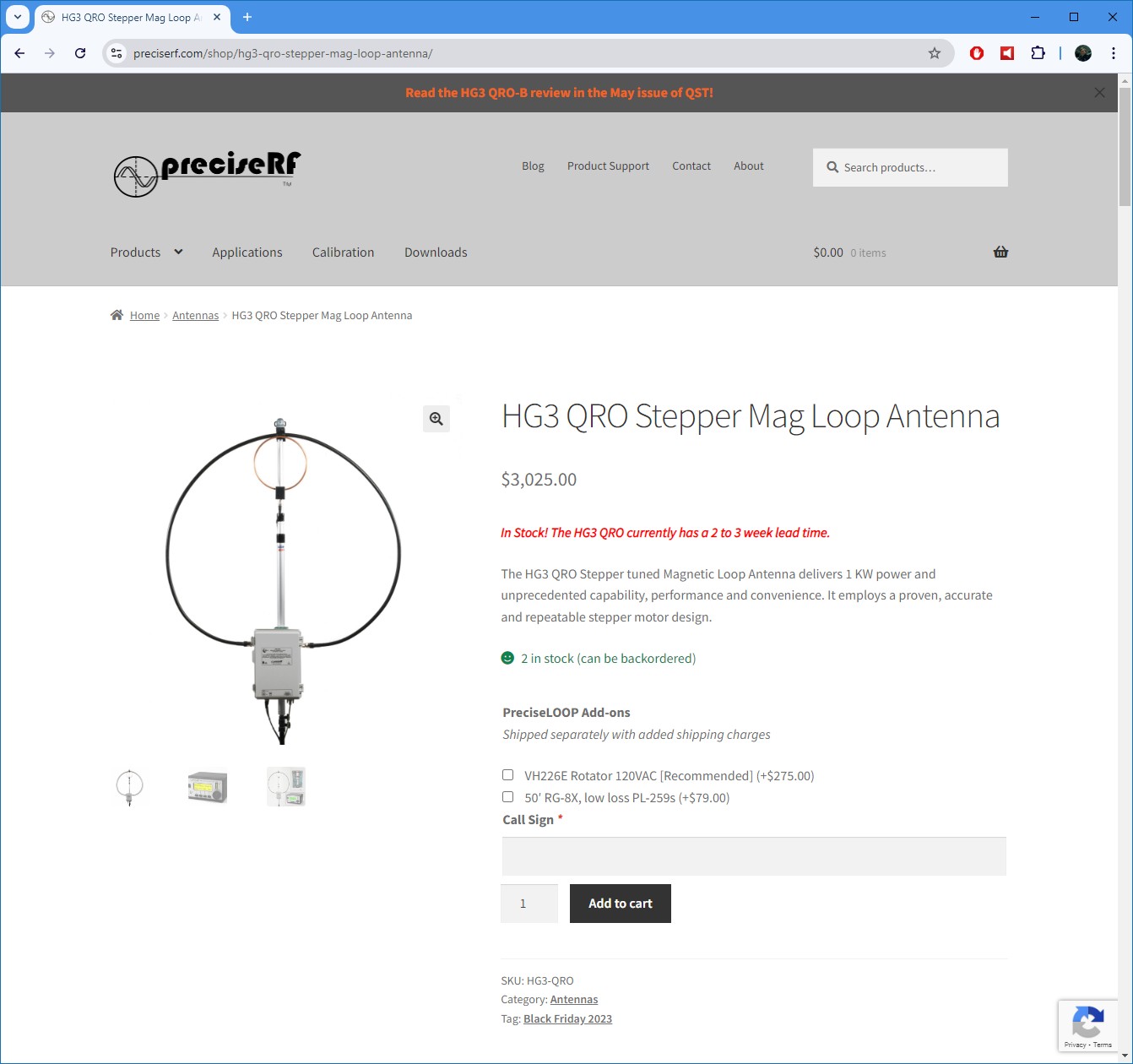
The other option is the Ciro Mazzoni Baby Loop. The Ciro is a tig-welded aluminum antenna that looks like a cross between abstract yard art, and a weapon you might see weilded by the villain of the latest marvel superhero movie. Most non-Hams are going to see it, scratch their head, and be confused. Rather than a vacuum capacitor, it uses an aluminum air variable capacitor. It also has an inside control box. The advantage of this antenna is its heavy construction and simplicity of design. The disadvantages are lack of precision due to the use of a linear actuator instead of a stepper drive.
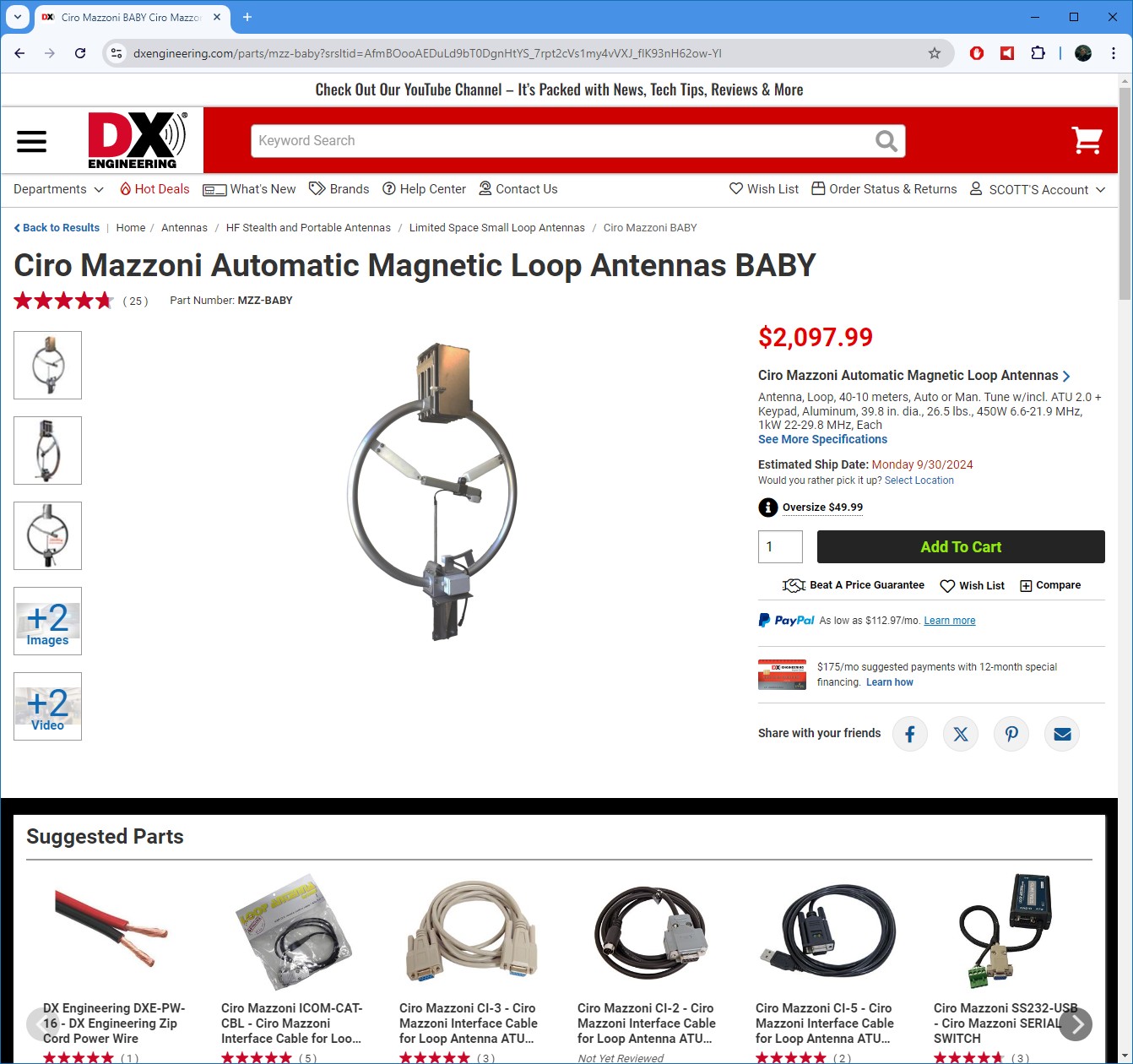
I chose the Ciro Mazzoni Baby Loop for several reasons:
- The overall simplicity of design and lack of electronics (even weatherproofed electronics) exposed to my very rainy winter.
- The heavy duty construction.
- It just plain looks cool.
I made one big sacrifice, where I think the PreciseRF would have done much better
- Precision of tuning. The Mazzoni’s linear actuator is probably not as precise as the PreciseRF’s stepper drive.
Maybe one of these years I’ll be in a situation where I can try out the PreciseRF
Choosing a rotator
Magnetic Loop antennas are considered to be highly directional, so having a rotator is very useful. I went with a Yaesu G-450ADC.
Setting up the Antenna, and a couple Quality Control Issues
For those in the EU your baby loop should come preassembled. For those of us in the US, it comes split into about 3 pieces in a large box. It’s not complicated to assemble. I was able to do it myself, though I would recommend getting a friend to help as the pieces are cumbersome to heft into place on your own
There were a few minor issues, however:
- The instruction manual was missing. This was not a big deal, as DX Engineering has the manual available for download.
- There was a bag of hardware — the hinge pin, actuator pin, and three bolts — that was a duplicate of hardware that was already installed on the antenna. Not that I complain about receiving extras, but it was weird to find hardware already installed.
- The two teflon guides, which mount to the capacitor frame, had come loose and were floating around inside the packaging. I managed to find them, but less than half of the hardware (M4 tapered machine screws and nuts) that was meant to mount them. I supplied the missing parts on my own.
- The bolt holes in the capacitor that mount the teflon guides were crudely deburred. This could explain why the guides fell off during packaging, if that is what happened.
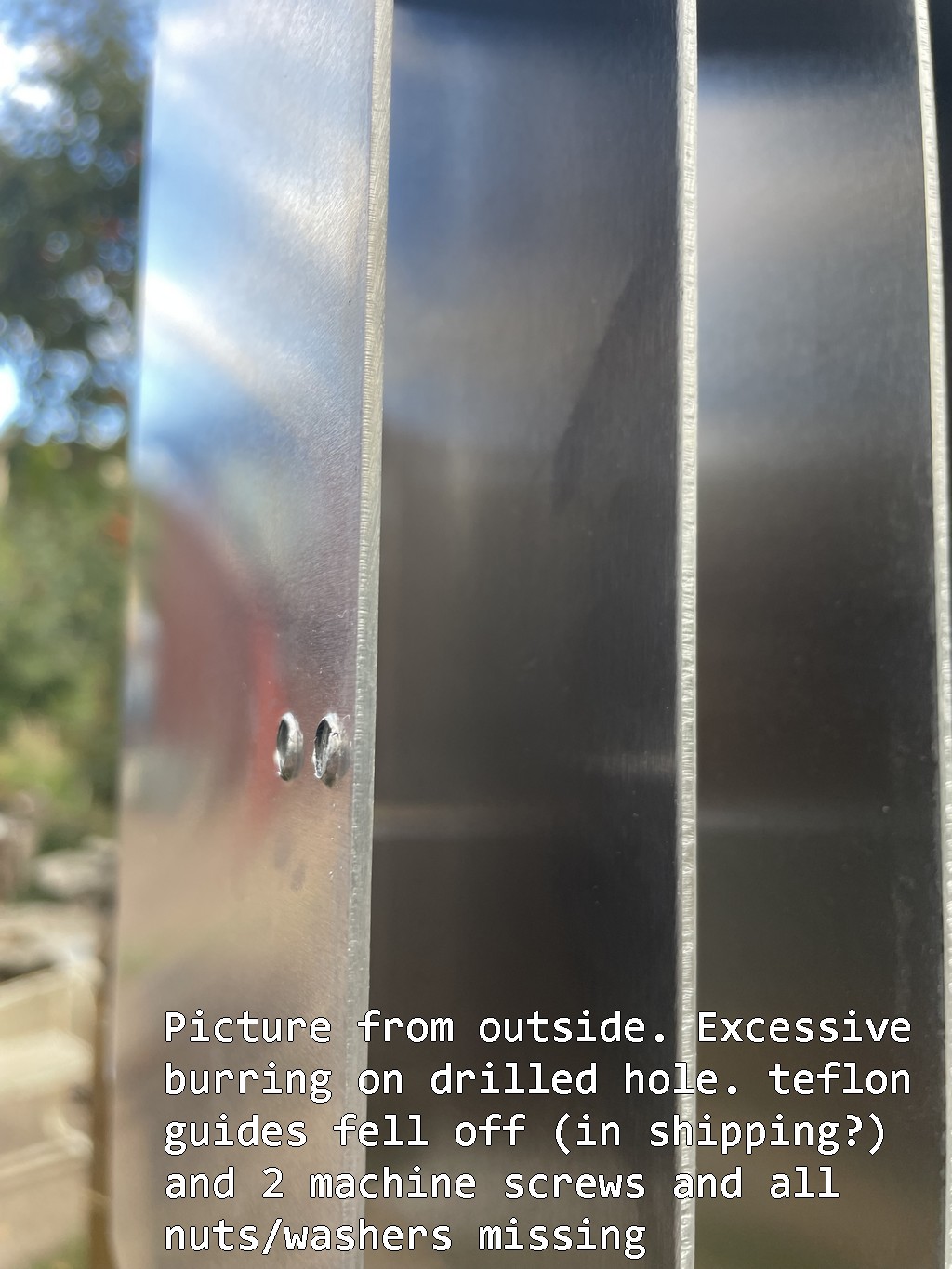
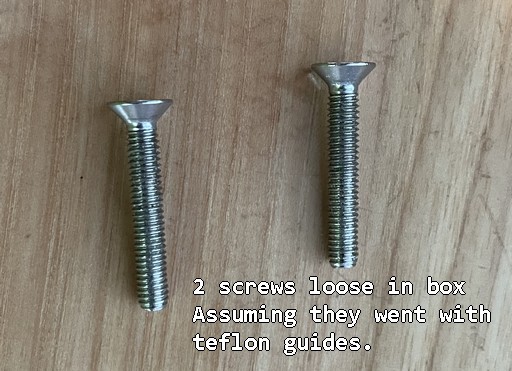
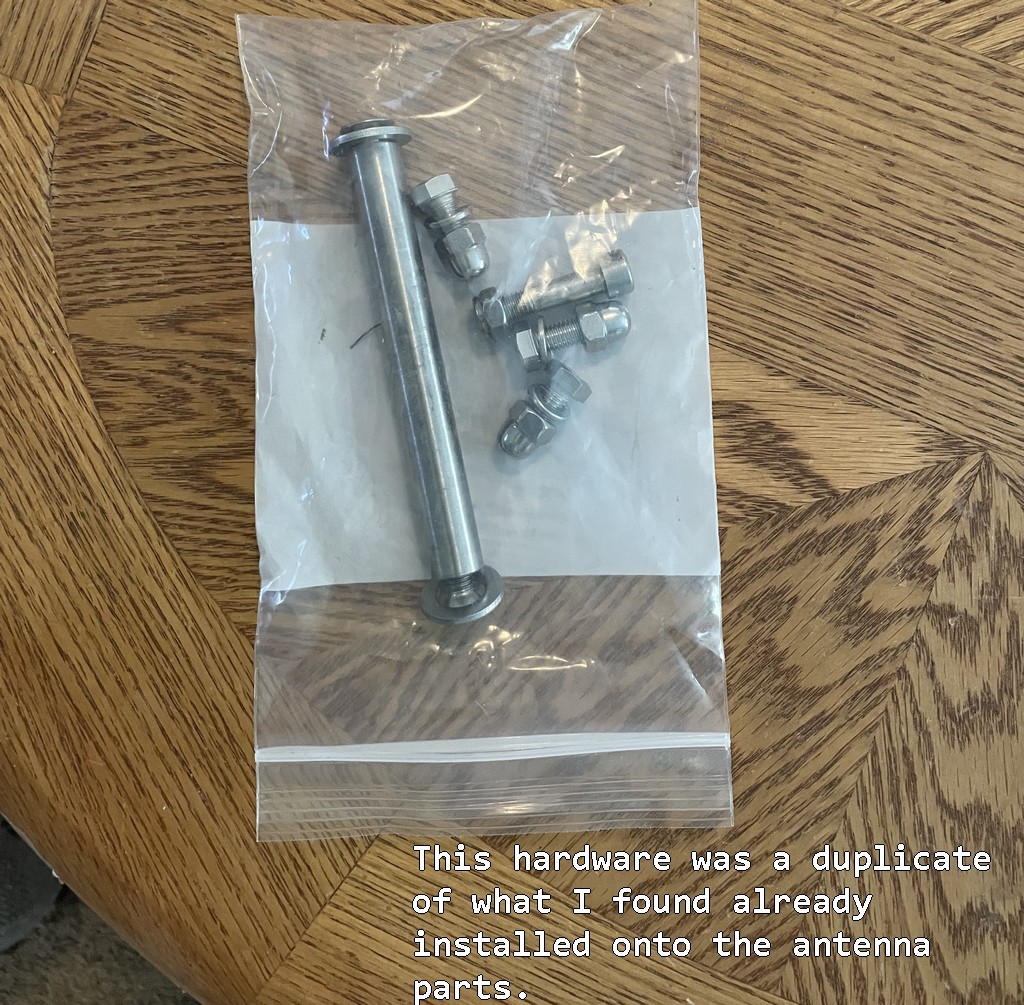
Here you can see the two Teflon Guides installed after I located replacement hardware and mounted them. They’re critical to keep the two halves of the capacitor aligned
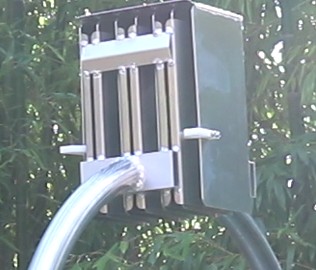
Ciro Mazzoni has a good reputation, and other then the crude deburring, the antenna is very very nicely constructed. It’s a shame they fell short on such silly things as forgetting to include the manual, or failing to debur holes in sheet metal. Regardless it wasn’t a big deal. I obtained a set of metric tapered machine screws for 8 bucks from Amazon and got my Teflon Guides mounted.
The staging area
It’s easiest to assemble the antenna on a short mast, so I pounded a 2″ chain link terminal post into the ground, and setup the antenna in a nice empty area.
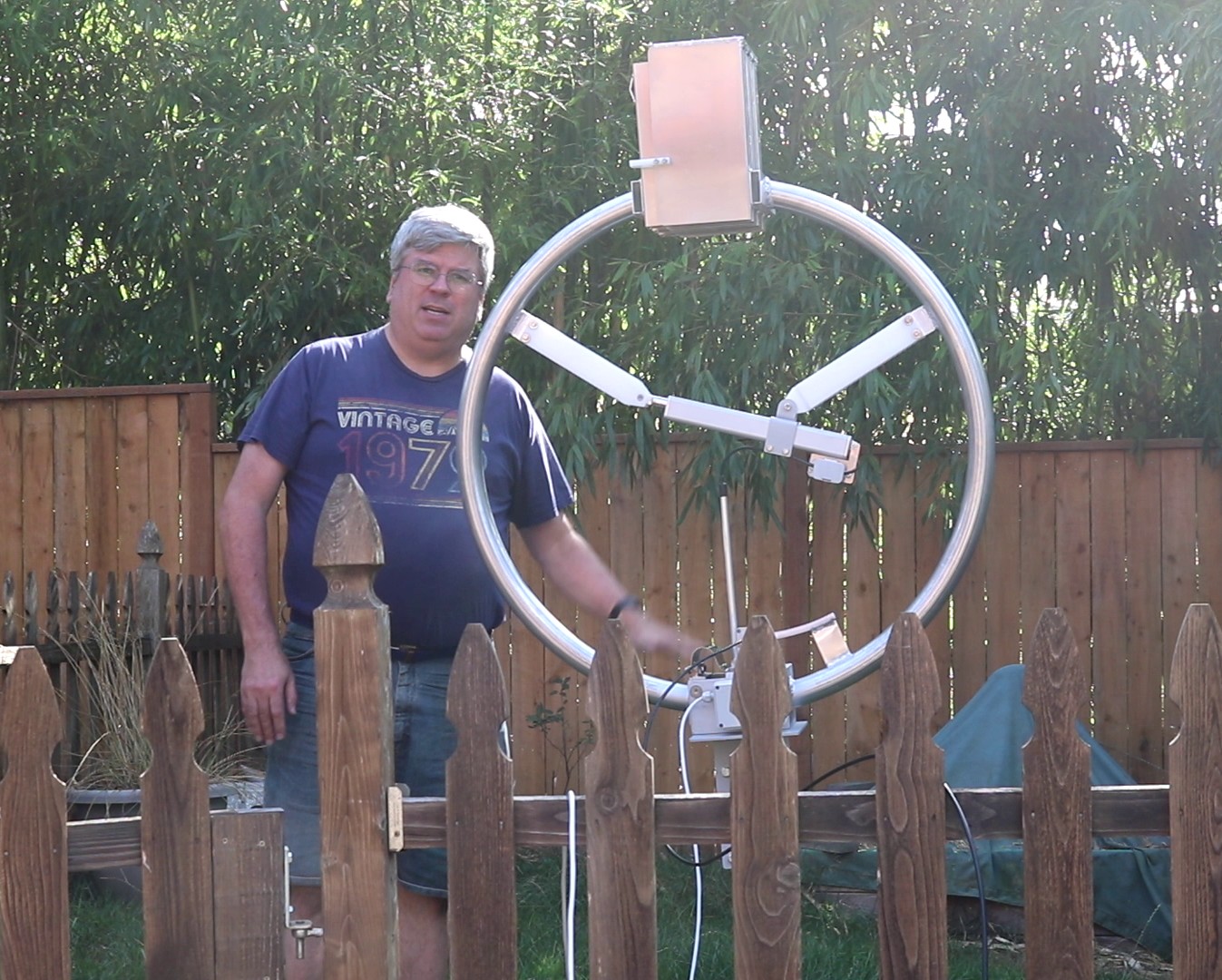
The antenna worked pretty good here, even as low as one loop diameter off the ground. I have some WSPR data lower on this page.
The roof mount experiment that failed
My intended location was to mount this on my second story patio roof. The nice thing about this location is that it’s about 8ft up which seems perfect for the antenna, and I can easily run coax to it. I read lots of stories about people mounting magloops in their balconies or in their attics, or even hanging off the side of their house. We have unobstructed views to the East, South, and West. The house blocked it to the North, but there’s little North of me. So I thought this would work.
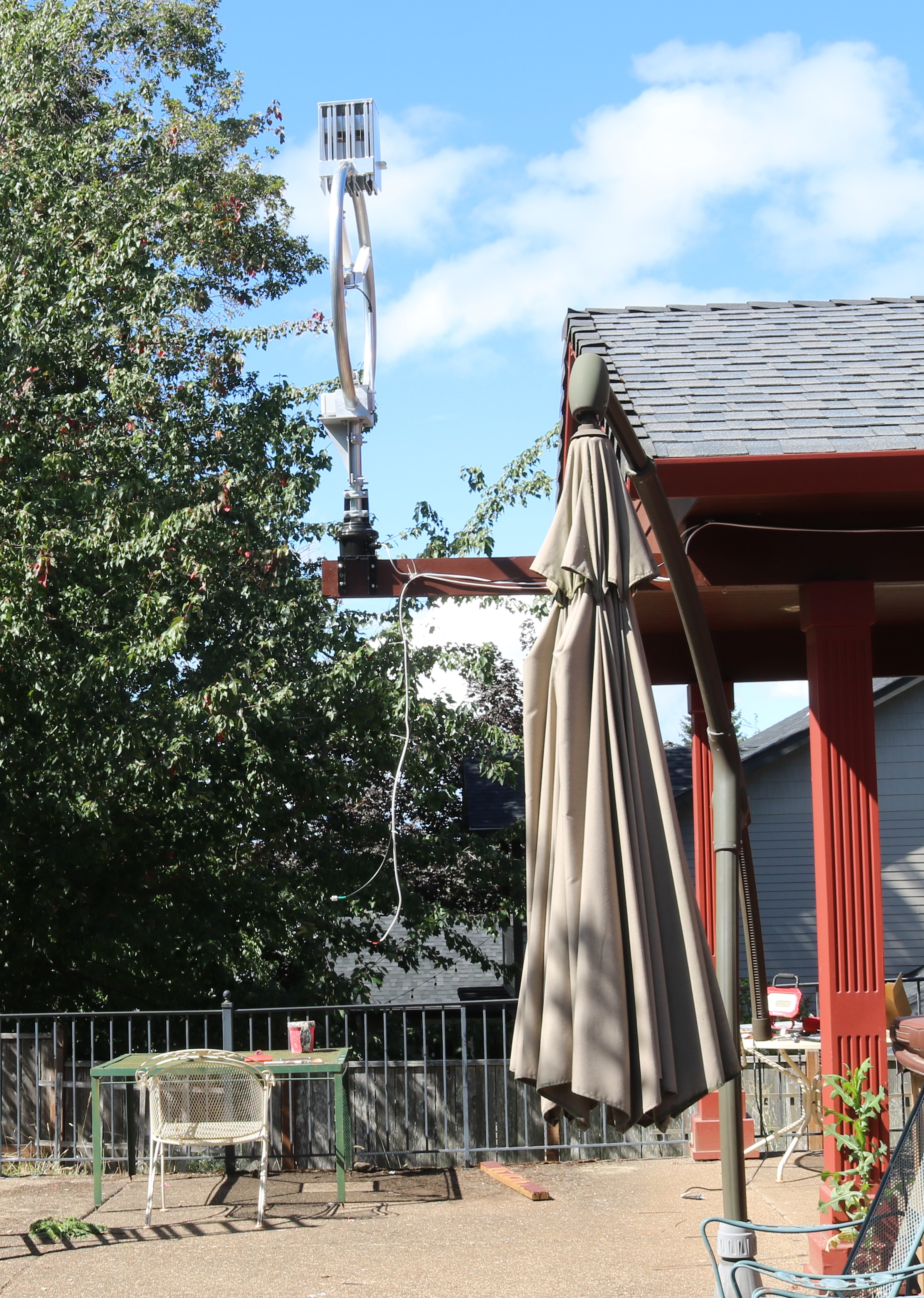
Unfortunately, it failed miserably. The antenna did not respond directionally as well as I thought it should. There was high SWR throughout, especially on 10M which was nearly unusable. The antenna did not seem happy here. I suspect it was interacting with metal rain gutters, metal flashing, something in the shingles, wood, …, who knows. If the antenna is not happy then you have to find a place to make it happy.
The backyard location
My backup location was the highest position in my backyard. The advantage here is that I could get it well away from any sources of metal.
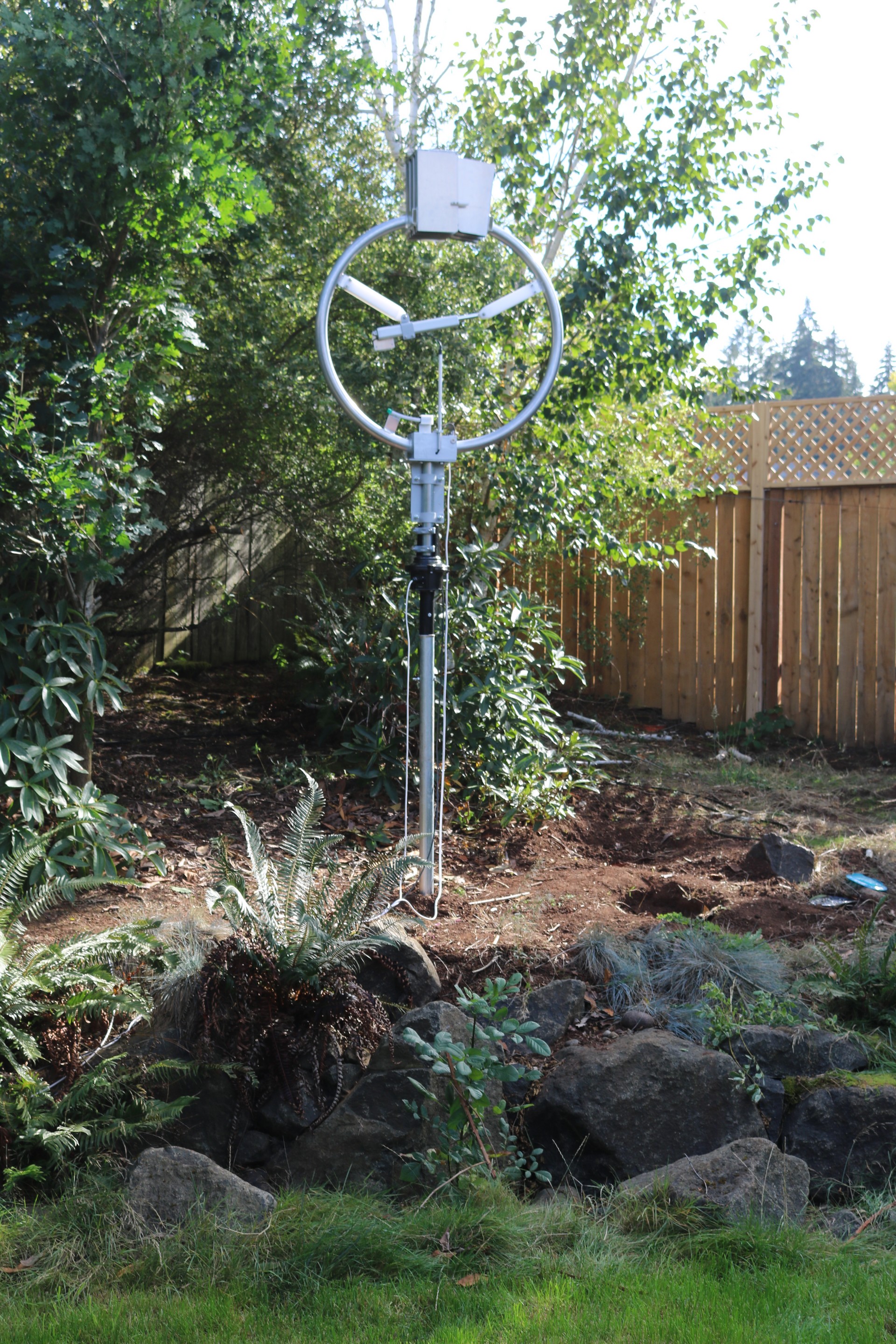
How does the variable capacitor work?
Well, it has a linear actuator that spreads the loop wider. Here are three views of the loop in approximate configurations for 10M, 20M, and 40M:
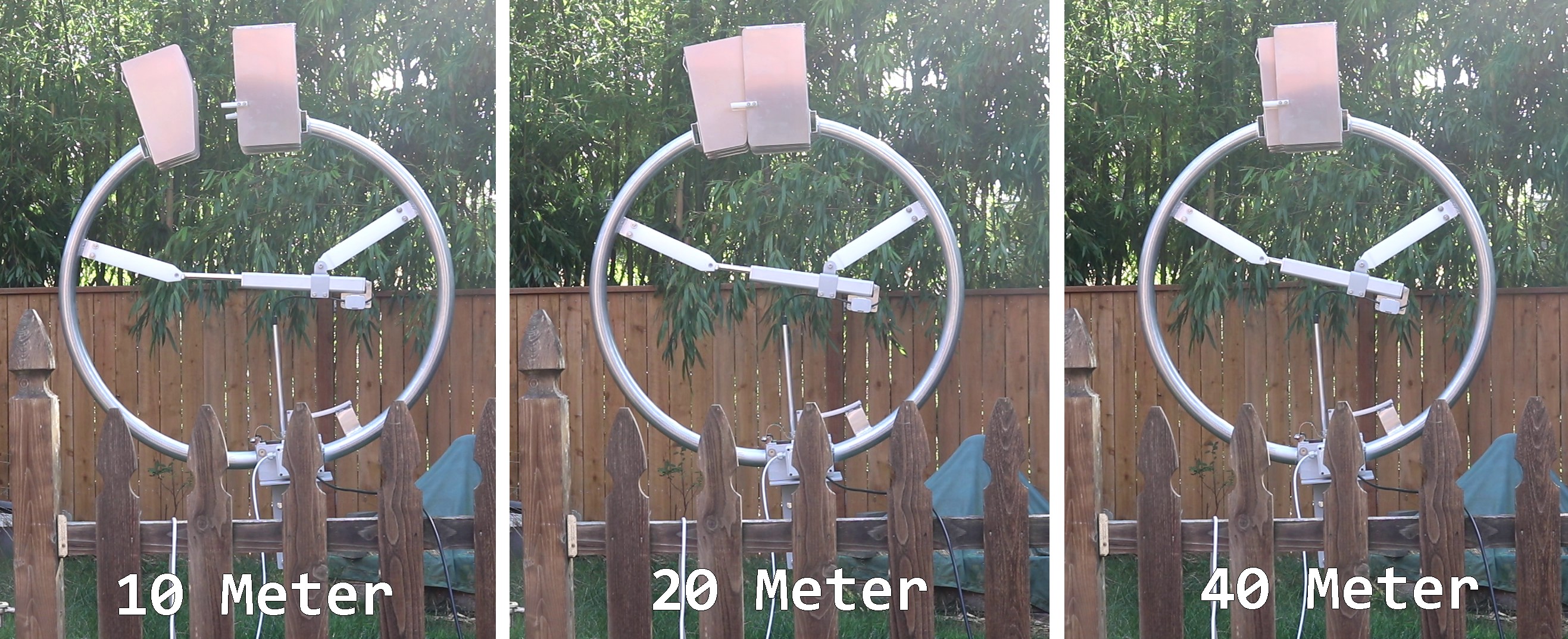
The capacitor is tuned by way of a microprocessor-controlled tuning box. The box has an attached keyboard. It also has an onboard signal generator and SWR bridge for measuring SWR. You punch in the frequency that you want on the keyboard and it will operate the motor in and out until the loop resonates at that frequency. This is not an exact science — the Ciro Mazzoni uses a linear actuator that does not have precision control. I believe what the tuning box does is to move it back and forth with short jots of electricity until it gets “close enough”. I’ll show some examples below:

In the above, you can see the Baby Loop’s tuning box on the bottom, and my Nano-VNA analyzer on the top. Sometimes pushing the tuning button will get you pretty far off as in my 1.9:1 example listed above. Other times you’ll get an intermediate result, and sometimes you’ll get a good result like 1.2:1 or even 1.1:1. As you can see on the Nano-VNA the loop is quite capable of achieving 1.1:1 SWR. It’s just that the approach Ciro Mazzoni took of using the linear actuator I feel doesn’t have the precision necessary to always get the tune “spot on”. It’s just a matter of repeating the process if the initial tune is not acceptable to you. My 20M was able to achieve 1.1:1 with enough patience.
Other bands you may not be so lucky. 10M, for example, and I cannot get below 1.6:1. That is the bottom of the curve. There must be something with my environment that 1.6:1 is just the best it can do on 10M.
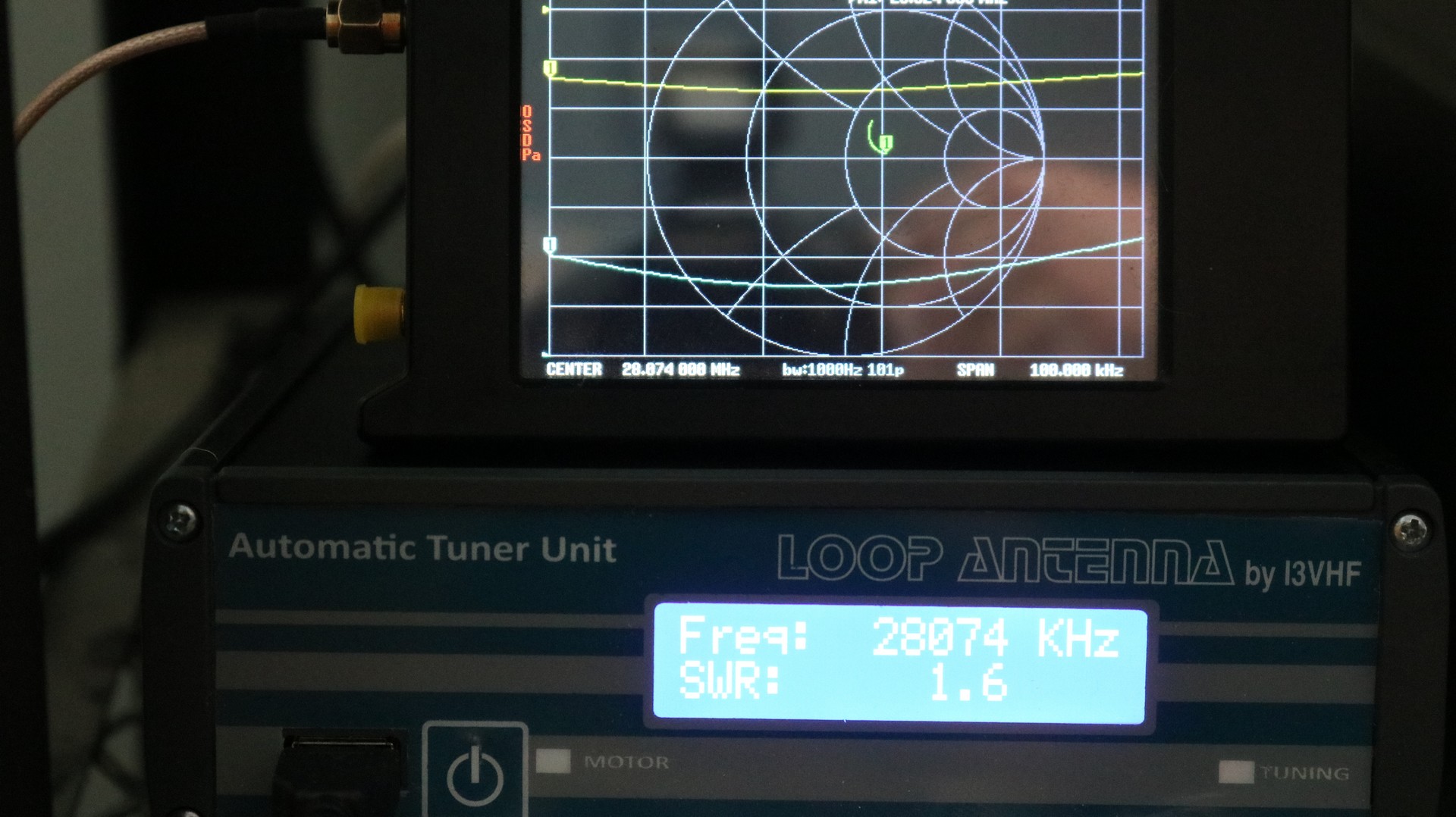
The bandwidth (with of the swr “dip”) varies by band. All of the Nano-VNA images I have in this section are 100KHz across the display. Compare the above 10M display to the following 40M and you can get an idea of the difference:
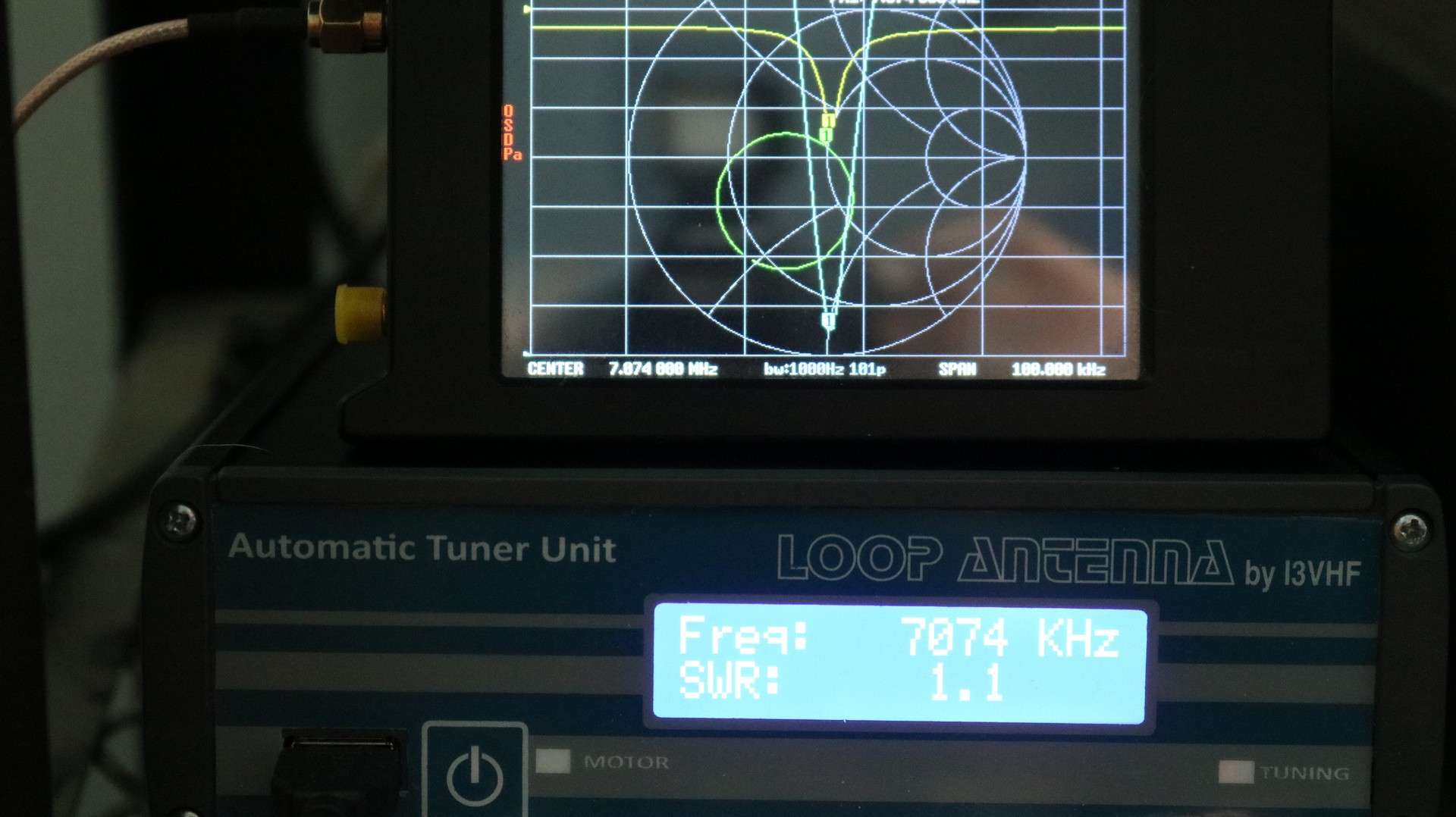
If you rotate the antenna, then you may need to re-tune it. If the sun goes down or the sun comes up, you may also need to retune it. I think the tuning varies with thermal expansion of the motor and related components. You can be happily transmitting at 1.4:1 SWR and then you glance over at the radio and find tuning has slipped and you’re now at 2.5:1 SWR.
The ability to automatically tune the loop to any frequency from 10M to 40M is one of the antenna’s greatest strengths, but it’s also one of the greatest sources of frustration. Sometimes on 20M it will stubbornly bounce between either side of the frequency and have great difficulty settling in. This is one place where I think the PreciseRF design might be better than the Mazzoni design, but I have no way to verify if that is true.
“Motor Fail No Load”
I’ve had this error message appear a couple times. The first worried me because I thought the motor might have actually failed, or more likely, my wiring to the motor had failed. I pulled loose the control cable and got out my ohm meter.
It turns out that what triggers this is the motor has extended fully outward (or fully inward) and is triggering a limit switch. Therefore the controller senses there is no current being drawn from the motor and issues this warning. I believe what is happening is that there is logic in the controller that determines the polarity of the motor. If this logic gets it wrong then the motor will move in the wrong direction — it’ll move it out when it things its moving in. When this happens if moves it all the way out to the stop.
There are two solutions:
- Switch the polarity of your motor leads on the back of the controller.
- Put the controller into diagnostic mode (press “/”) then press 9 or 1 to move it away from the stop. Then turn the controller off and then back on again.
Spontaneous Tuning
I’ve had a couple instances where I was transmitting on 20M, and the tuner suddenly entered a tuning cycle. This disconnects the radio while tuning, immediately causing an SWR issue. Adding some ferrites to the wires going to the controller may have resolved this — I’m going to wait and see if the problem has gone away.
Directionality
The antenna is directional. For example, take a look at these two pictures:
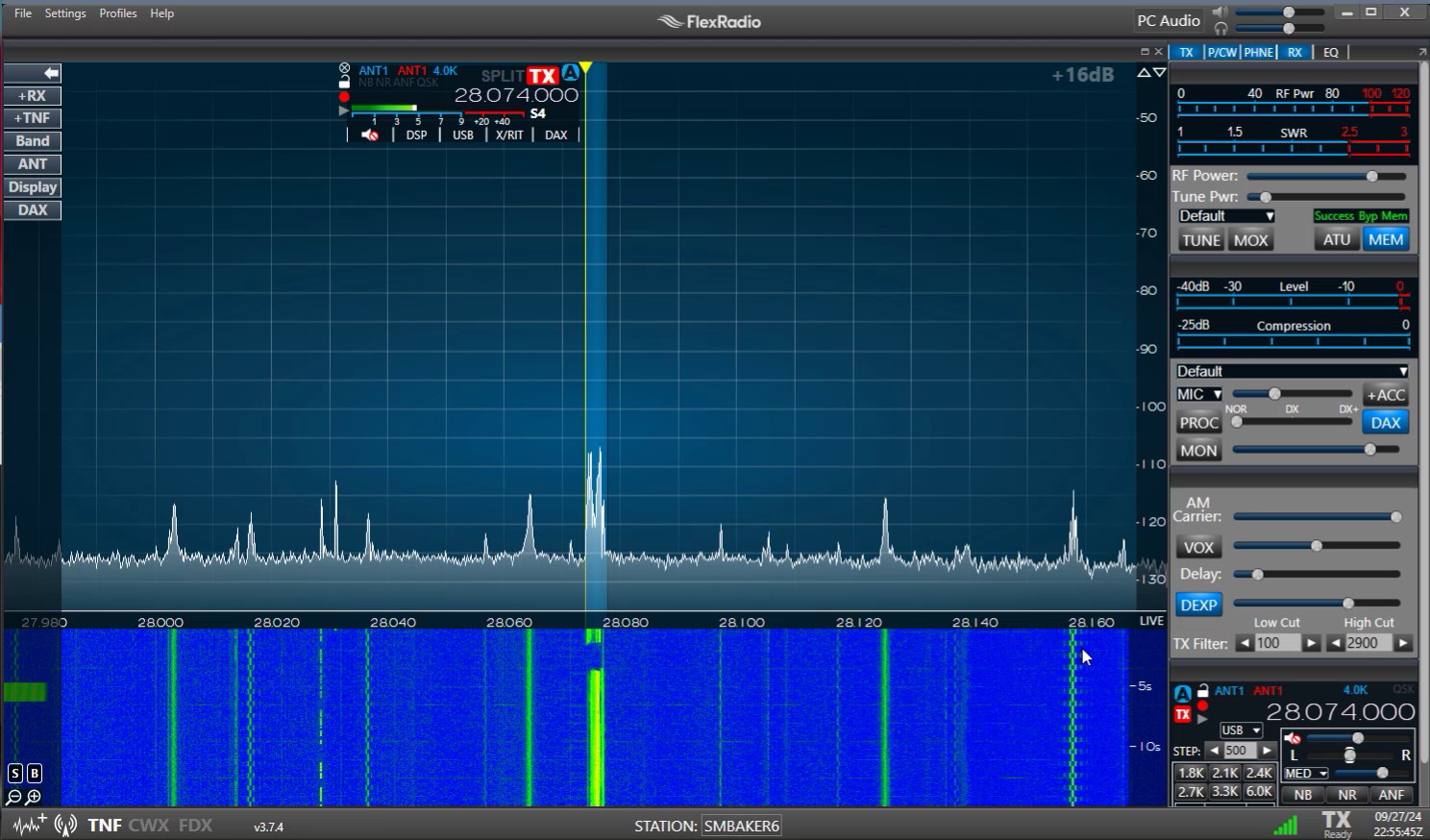
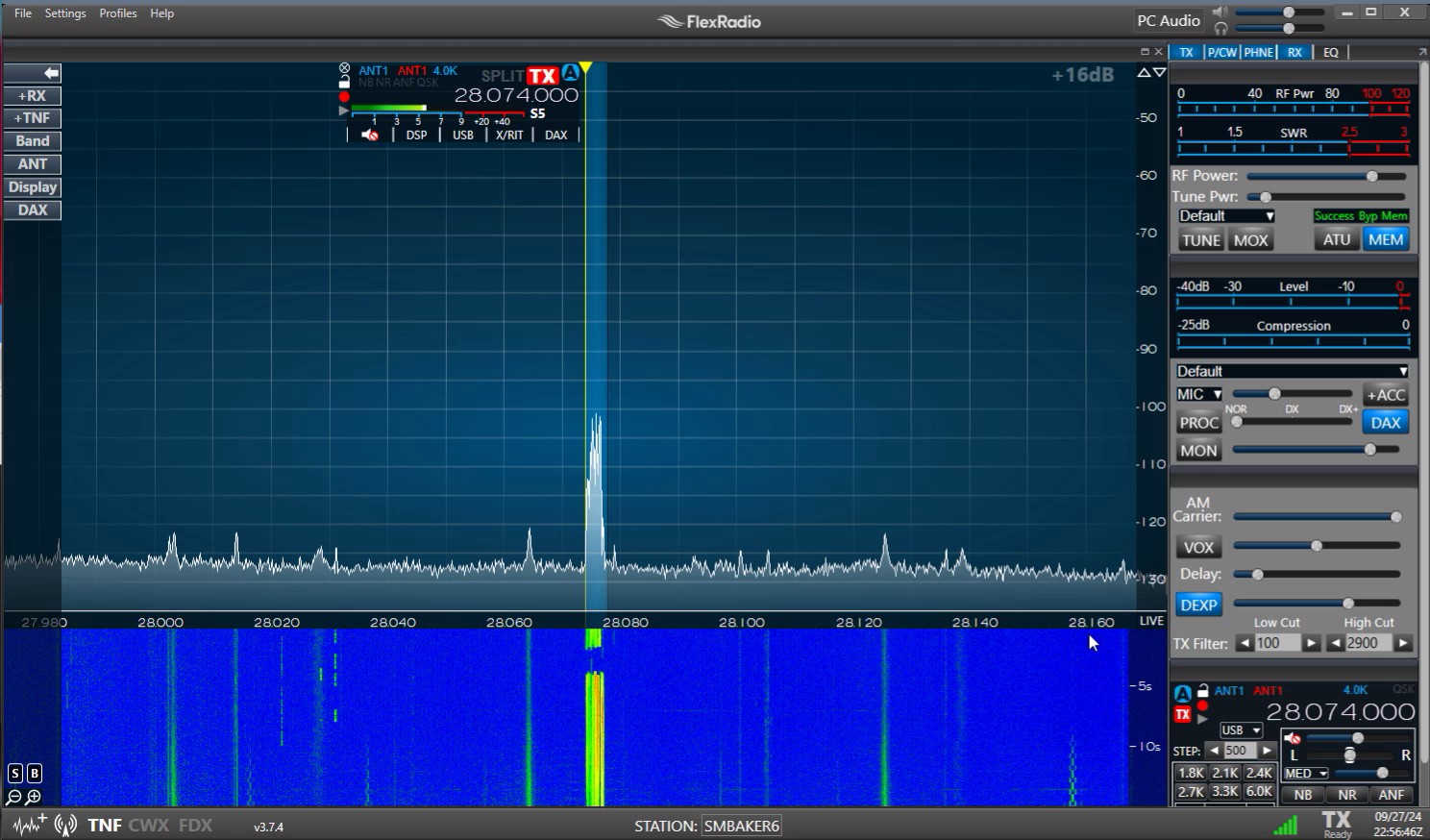
Looking at the first picture, you can see some persistent noise, especially at 28.160. Rotate the antenna 90 degrees for the second picture and that noise has been nulled out. Of course, the challenge is to null out the noise without nulling out the signals you’re interested in. Obviously that’s going to depend on the signal and noise not being in the same direction.
On phone, I have a few anecdotes to pass on. Talking with a fellow ham in California, we were each picking each other up at about S7. My antenna was about 45 degrees off, when I rotated it to be spot on, my reception of him went to S9 and I believe he said his reception of me went to S9+20. I had a similar experience with a station in Arizona — rotating the antenna we managed to completely lose one another. It helps to find fellow hams who are open to experimenting with the antenna to confirm experiences.
This seemed to be prevalent with stations that are south of me. I swear, stations that are east of me, it doesn’t seem to matter which way the antenna is rotated. Propagation can be a funny thing.
WSPR Performance
I tried the antenna out using my ZachTech WSPR transmitter. This is a small device that transmits as a WSPR beacon at about 200mw of power. Some results are below:
| Antenna | Reports | Grids | Furthest | Closest | Highest | Lowest |
|---|---|---|---|---|---|---|
| EFHW (1) | 432 | 28 | 3388 | 709 | 0 | -34 |
| EFHW (2) | 3113 | 108 | 13068 | 403 | 18 | -33 |
| EFHW (3) | 3455 | 55 | 13068 | 93 | 19 | -33 |
| Baby-Staging-Area-4FT | 2038 | 59 | 12237 | 660 | 13 | -34 |
| Baby-Final-6FT-EW (1) | 988 | 58 | 8304 | 929 | 9 | -34 |
| Baby-Final-6FT-EW (2) | 2041 | 45 | 13047 | 403 | 11 | -33 |
| Baby-Final-6FT-EW (3) | 2970 | 55 | 4044 | 403 | 10 | -33 |
| Baby-Final-6FT-EW (4) | 2755 | 34 | 2595 | 624 | 10 | -34 |
| Baby-Final-6FT-NS | 1420 | 41 | 13247 | 709 | 12 | -34 |
The above experiments were each run for 8 hours, from 10am to 6pm pacific standard time.
Take the above with a grain of salt as propagation is bound to have some effect on the numbers. But one thing to note from these results is that the performance at 6ft was not significantly different from the performance at 4ft. If anything the 4ft numbers might be a little bit better. This could be due to a number of factors, including that when the antenna was in the “staging area”, there was absolutely nothing around it, whereas in the final location there are some trees in close vicinity.
Also, note that it does make sense to repeat the above experiment several times. I have put multiple runs in parenthesis. Note that EFHW (1) and EFHW (2) show a great deal of variation. Why? Epic bad propagation? or did I somehow now have a cable fully screwed in? Had I not repeated the experiment, I would have surely drawn the wrong conclusion.
FT8 Performance
I’ve made contacts on 40M, 30M, 20M, 17M, 15M, 12M, and 10M. Most of the contacts I make are within the continental US, though my location also gets me good access to Japan and Australia and New Zealand. I get sporadic rare FT8 contacts in Europe, South America. I get very rare contacts in Africa. In my experience this antenna is not some magical device that’s going to grant you instant DX.
I feel my EFHW outperforms the magloop on 40M, but the magloop outperforms the EFHW on every other band. Specifically I bought this to get more experience with 20M. My EFHW has a lot of problems on the 20, including making devices inside my home go haywire. The magnetic loop doesn’t seem to be causing those problems.
One night on 20M I managed to get bless with good conditions, and the antenna managed to tune 1.0:1 SWR (I didn’t even know it was possible, but yes the FlexRadio was reading 0.0W returned power). I worked dozens of stations in Europe that night.
Phone Performance
I’m not much of a phone operator — I make the occasional contact now and then. Since getting the baby loop, I have made contacts to:
- California (720 miles)
- Arizona (933 miles)
- Ohio (2072 miles)
- Alaska (1617 miles)
- Alberta, Canada (786 miles)
- Texas (1683 miles)
- Nevada (681 miles)
- Michigan (1910 miles)
- Arizona (940 miles)
As I said, I’m not a big phone operator. The above is consistent with the type of contacts I’m able to reach with the EFHW. I have been able to hear from lots of stations to the east, some as far as New Jersey, but many of these contacts to the east I can hear but they can not hear me.
As I mentioned before, I don’t feel like this Magnetic Loop is a magic DX device. My location has a lot of trouble getting out to the east and I think the only way to get past those problems is going to be height, which I just can’t get at my location.
Conclusion
I like the antenna. It’s neat. Nothing else looks quite like it. With ham radio, we strive to do unusual interesting things, and a magnetic loop antenna certainly qualifies.
However, the magnetic loop is not magic. It does let me easily tune several bands that I could not tune on my EFHW and that has offered me some new options. Could I have achieved the same with a good wide range antenna tuner on my EFHW or even a rain gutter? Maybe, but the WSPR numbers do confirm that on 20M to Ciro Mazzoni is outperforming the EFHW. There may be a lot of dependence on the particular band. Each QTH is going to be different so my experience may not be your experiences.
Tuning, as I complained above can be a bit of a pain. I do not like having to push the tune button several times to get it to eventually settle on a “good” SWR. I also do not like when I find the antenna has suddenly gone out of tune, particularly when the sun goes down and the temperate cools off.
What a very detailed description of using the Ciro Mazzoni Baby-loop. I have had one at my QTH for over 2 years. I have been extremely pleased with its performance on SSB and ft8. The base of my loop is 8 feet above ground. It works for my small lot. Would I wish that I had space for a multi band yagi up 50 feet, sure. A hexbeam won’t fit for me due to wires. So the Baby-loop is my directional antenna and it works.
Buenas tardes soy CD3FZS y me fabrique una loop magnetica casera y funciona bien en 40mt. Mi consulta es que medidas tienes las láminas del condensador y cuantas trae y que diámetro es el tubo del loop y el diámetro del loop, saludos 73
Mi correo es cd3fzs@gmail.com
Interesting article, thank you. Very nice graphics, and well thought out.
I bought the the Midi in 2016. At that time, there was no dealer in the US, so I bought it from WiMo, in Germany, but I had to arrange for shipping. I built a very rigid rotating mast for it. The antenna did come with all parts. I have to say, I had no practical idea of how much work it would be to set up the antenna, which when assembled is huge.
It was fantastic on 40 and 80 meters, at times better than my dipole. It was also very directional on 40 and 80, which surprised me.
But the problem was arcing, I tuned up at 200 watts, which I thought was a modest amount, but it was a light show in my back yard, and I could hear the crackling inside the house. No matter what I did, it would arc when I got a little over 100 watts. Also, they were still working out the bugs on the new ATU 2.0, and it took me a few weeks to sort out the baud rate problems and other connectivity issues. I could not live with the arcing, and I sold it.
Then, in 2023, I bought the PreciseRF HG3 QRO. Eight years is a long time for technology these days, so perhaps Ciro has made big gains in the ATU and the other issues, but even with my apples to oranges comparison, the PreciseRF tuner is for me, far, far, better. It handles 1500 watts (some bands are at 800 watts) And with that capacity, the loop is very easy to handle. It can fit in the trunk of one’s car. I have a 500watt SS amp, and it handles the power with no problem. The control box reminds me a bit of the StepperIR beam I had in 2000, very smooth and works automatically.
After getting the QRO, I did wonder if maybe I should have tried to convert the loop from the stock capacitor to a vacuum variable instead, that most likely would have cured the arcing. But have spend the time to make the mast, put it all together, and then have a 100 watt power limit was disappointing.
It’s very interesting to hear your experience. Wish I had a PreciseRF to compare against (maybe next year). I still do have a bit of issue getting the baby loop of tune well — it likes to overshoot or undershoot the desired frequency. Usually it’ll land within 1.5:1 SWR, but occasionally it’ll take a few tries to get it there. How is the PreciseRF? I’m assuming the vacuum cap and the stepper motor can hit the sweet spot reliably?
Question to Tom Beltran: Do I interpret your post right that you use the PreciseRF HG3 QRO tuner to the Ciro Mazzoni Baby Loop?
I have huge problems with “Motor Fail No Load”. The tuner tries to tune but never find the resonant frequency. I can see that the motor is not drawing any current (the blue light does not light up). But I can drive the motor manually (by pressing / for 3 seconds and use the keyes 9 or 3), So the motor works. I have checked the connections at the antenna and they seem to be OK. The problem was not present until after a year of operation. I have no clue what could be the problem. Does anyone one have any tips?
Philip Nystromer, I have the same problem.
Sunday I am still transmitting and on Monday it did nothing
I can operate the motor manually but the unit does’t tune anymore.
Is there perhaps also an electronic diagram in circulation so that I can check it on the print.
Otherwise the unit has to be sent to Italy and that costs 190 euros for repair.
Excellent review. Honest and very useful. I agree with you on many points. I was very disappointed with their build quality, alignment, welding by a novice, one even fell apart. Did they care . Nope.
I bought mine secondhand, it did not tune.
There was corrosion on the flexible joint.
It’s very important to make sure there is no oxidation there it should be cleaned and greased with special Grease. Just check the antenna which and an analyser and if you cannot find a dip then you know what the problem is.
Very good article. I just bought the Mazzoni Baby Loop and are experiencing difficulty with the tuning staying stable. It will tune nicely most of the time but will need frequent retuning. Sometimes minutes later, sometimes hours later. It’s cool, but not reliable. I am currently working with DXengineering on a resolution but honestly I think I would like to return it if possible.
I have found that it is fairly sensitive to sun and wind. The other days I was having issues with it slipping out of tune every couple minutes, and it was a very windy day. I do wonder if putting some preload on the hing would help (like using a spring or bungee cord or similar to ensure there is constant tension against the worm gear)
I have been working with DX Engineering on the SWR drift issues which appear to be the same as what you are experiencing. The antenna is currently mounted on my covered deck about 14ft off the ground. This seemed to initially work fine but now I’m having tuning issues. The weather has been much hotter since the initial install and so has the humidity (there’s been very windy days as well). There may be some thermal expansion occurring on the actuator as hot as it has been. I plan on mounting it on the ground over the next few days at about 2.0 meters (6.5 ft) off the ground as DX engineering has suggested but I don’t have a lot of faith that will cure the erratic SWR values but worth a try. Interesting to note that DX Engineering say’s they have never heard of this issue, yet it seems to be common (not sure I believe them).
I’m also going to collect actuator displacement values with a caliper to see if there is any difference when it “drifts”. All in all I’m going to take a lot of mechanical and electrical data with my VNA in hopes of getting to the root cause.
Great antenna when it is working but this tuning drift seems to be an inherent problem that many are facing, at the large price tag it should be better.
Very interesting article cooments.
I have been using different magloops for a few years.
MFJ1788 horizontally mounted on the balcony 25M AGL.I often use Spiderloop A100,OK2ER magloop and home made mla on the balcony.
I have never had any problems with tuning and getting low SWR.
The same when I use mla indoors,from the beach and other portable locations.Usually on a tripod.
Using only MLA and mobile whips I have had QSOs with almost 300 countries.PWR max 100 W.
Maybe I am lucky..
73
Andy SP9HZX
Awesome article and on spot. I’ve had one 3 years ago on my home about 9 meters from the ground without using a rotator.
I was very happy with it. Especially, I did like the fact that you have way less interference / issues caused by the neighbors using cheap led power supplies or have solar panels in use.
We moved to another home and therefore, I sold it.
Meantime, I was offered a Maxi loop, which apparently couldn’t get to work due to spare parts missing and able to purchase.
The Maxi went to an OM who is trying to get it back to life.
Anyway, now I’m missing my baby loop.
Recently got an offer from an OM to disassemble his baby loop from his roof due to his bad health condition. It’s a poor story though. But I definitely will take it and put it on my garage.
Does anyone know, if there’s an option to change the motor to a stepper version with matching controller?
I came along e.g. this controller so far:
https://sites.google.com/site/lofturj/13-to-automatically-tune-a-magnetic-loop-antenna
I think a stepper upgrade would be something nice for this awesome antenna.
Cheers, André DF3QQ